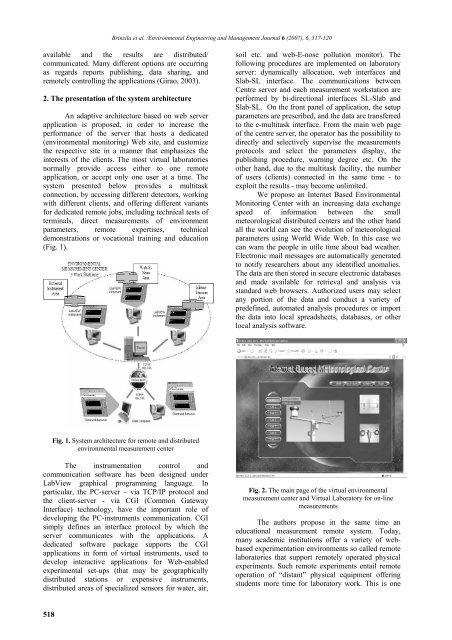2007_6_Nr6_EEMJ
Create successful ePaper yourself
Turn your PDF publications into a flip-book with our unique Google optimized e-Paper software.
Brinzila et al. /Environmental Engineering and Management Journal 6 (<strong>2007</strong>), 6, 517-520<br />
available and the results are distributed/<br />
communicated. Many different options are occurring<br />
as regards reports publishing, data sharing, and<br />
remotely controlling the applications (Girao, 2003).<br />
2. The presentation of the system architecture<br />
An adaptive architecture based on web server<br />
application is proposed, in order to increase the<br />
performance of the server that hosts a dedicated<br />
(environmental monitoring) Web site, and customize<br />
the respective site in a manner that emphasizes the<br />
interests of the clients. The most virtual laboratories<br />
normally provide access either to one remote<br />
application, or accept only one user at a time. The<br />
system presented below provides a multitask<br />
connection, by accessing different detectors, working<br />
with different clients, and offering different variants<br />
for dedicated remote jobs, including technical tests of<br />
terminals, direct measurements of environment<br />
parameters, remote expertises, technical<br />
demonstrations or vocational training and education<br />
(Fig. 1).<br />
soil etc. and web-E-nose pollution monitor). The<br />
following procedures are implemented on laboratory<br />
server: dynamically allocation, web interfaces and<br />
Slab-SL interface. The communications between<br />
Centre server and each measurement workstation are<br />
performed by bi-directional interfaces SL-Slab and<br />
Slab-SL. On the front panel of application, the setup<br />
parameters are prescribed, and the data are transferred<br />
to the e-multitask interface. From the main web page<br />
of the centre server, the operator has the possibility to<br />
directly and selectively supervise the measurements<br />
protocols and select the parameters display, the<br />
publishing procedure, warning degree etc. On the<br />
other hand, due to the multitask facility, the number<br />
of users (clients) connected in the same time - to<br />
exploit the results - may become unlimited.<br />
We propose an Internet Based Environmental<br />
Monitoring Center with an increasing data exchange<br />
speed of information between the small<br />
meteorological distributed centers and the other hand<br />
all the world can see the evolution of meteorological<br />
parameters using World Wide Web. In this case we<br />
can warn the people in utile time about bad weather.<br />
Electronic mail messages are automatically generated<br />
to notify researchers about any identified anomalies.<br />
The data are then stored in secure electronic databases<br />
and made available for retrieval and analysis via<br />
standard web browsers. Authorized users may select<br />
any portion of the data and conduct a variety of<br />
predefined, automated analysis procedures or import<br />
the data into local spreadsheets, databases, or other<br />
local analysis software.<br />
Fig. 1. System architecture for remote and distributed<br />
environmental measurement center<br />
The instrumentation control and<br />
communication software has been designed under<br />
LabView graphical programming language. In<br />
particular, the PC-server – via TCP/IP protocol and<br />
the client-server - via CGI (Common Gateway<br />
Interface) technology, have the important role of<br />
developing the PC-instruments communication. CGI<br />
simply defines an interface protocol by which the<br />
server communicates with the applications. A<br />
dedicated software package supports the CGI<br />
applications in form of virtual instruments, used to<br />
develop interactive applications for Web-enabled<br />
experimental set-ups (that may be geographically<br />
distributed stations or expensive instruments,<br />
distributed areas of specialized sensors for water, air,<br />
Fig. 2. The main page of the virtual environmental<br />
measurement center and Virtual Laboratory for on-line<br />
measurements<br />
The authors propose in the same time an<br />
educational measurement remote system. Today,<br />
many academic institutions offer a variety of webbased<br />
experimentation environments so called remote<br />
laboratories that support remotely operated physical<br />
experiments. Such remote experiments entail remote<br />
operation of “distant” physical equipment offering<br />
students more time for laboratory work. This is one<br />
518


